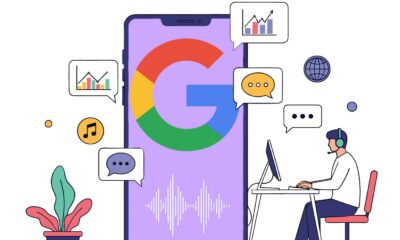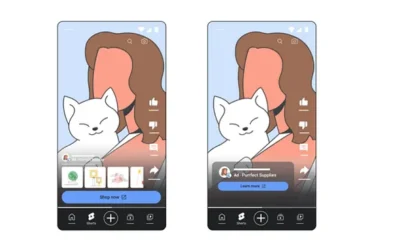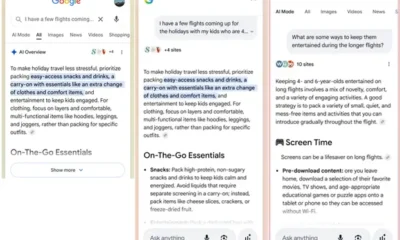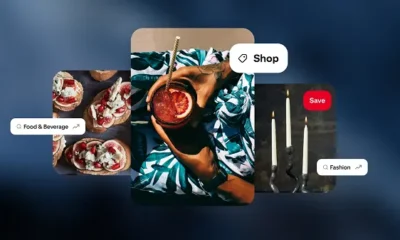SEO
11 Social Media Content Types & Examples

Social media has been at the forefront of digital marketing for quite some time, and it’s unlikely this will change in the near future.
In fact, we are still seeing new social media channels and platforms emerge – alongside a wide variety of content types, features, and formats.
This article will cover the top social media content types and which channels they are best suited for.
We will also highlight some of our favorite examples of how brands have excelled in each type of content.
Let’s dive in.
1. Short-Form Video
If you’ve spent any time on social media in the past few years, you know that short-form video has become one of the most common – and popular – types of social content.
Short-form video could be defined as any piece of video content that is under 10 minutes long, but typically, the shorter, the better. When I think of short-form video, I think of video content around 0-3 minutes long.
From Reels to TikTok to YouTube Shorts, short-form video has proven to be an incredibly effective format for reaching audiences on social media.
Why? Because, when done right, it packages compelling visual storytelling into a bite-sized, digestible piece of content – which is exactly what today’s increasingly distracted and busy users are looking for.
Short-form video is also versatile. You can use it to achieve different objectives, whether showcasing internal thought leadership, highlighting a customer case study, or featuring your product.
The Best Social Media Channels For Short-Form Video
Given the demand for short-form video, it works well across most social media platforms, from TikTok to LinkedIn. However, the following stand out as the best fit:
- TikTok – This one should be obvious. As the most popular social media platform worldwide, TikTok is the leader in short-form video.
- Instagram – With the introduction of Instagram Reels in 2020, the platform has leaned into short-form videos. If you create short videos on Instagram, the algorithm will likely reward you.
- YouTube – While YouTube is better known for long-form videos, which we’ll dive into below, the platform has also been branching into short-form videos. It launched YouTube Shorts in 2020, which now has over 1.5 billion monthly users.
- Snapchat – The pioneer of the ephemeral video story, Snapchat has somewhat faded into the background in terms of social media chatter. But don’t be fooled; it has over 530 million monthly active users.
Brand Example: Short-Form Video
Mediterranean fast casual food brand, CAVA, is a great example of a company that leverages short-form video on social media.
The brand has amassed over 87,000 TikTok followers by making fun, snappy video content that features CAVA’s products and often employs trending TikTok sounds or formats.
Here is an example of a video where CAVA used a comment by a customer to create video content.
@cava Jeffrey stamp of approval ☝️ #CAVA #foodreaction #saladrecipe #foodreview
2. Long-Form Video
Long-form video is video content that is 10 minutes long or longer.
And while you may not see as much of it in your day-to-day social media activities, it definitely plays an important role in brand marketing.
Long-form video can be a powerful tool for more in-depth brand storytelling and content.
Some examples of long-form video content you may want to leverage for marketing purposes are documentaries, branded series, video profiles, interviews, and more.
The Best Social Media Channels For Long-Form Video
If you’re interested in distributing long-form video content on social media, YouTube is where you want to be.
YouTube is the leader when it comes to long-form videos, and you’re most likely to find your audience there.
While you can – and should – share shorter clips and cutdowns from your video on apps like Instagram, Twitter, Facebook, LinkedIn, and TikTok, many of these platforms won’t even allow you to upload longer videos.
Brand Example: Long-Form Video
The team behind BuzzFeed’s Tasty knows what it takes to make great social videos, including long-form content.
Tasty’s YouTube channel features tons of video content, ranging from quick recipes and tips to series like “I Draw, You Cook” – an episode of which is featured below.
3. User-Generated Content (UGC)
User-generated content, or UGC, is content created by individuals unaffiliated with your brand about your brand – and it’s perfect proof of what makes social media content so powerful.
Over the past decade or so, UGC has become one of the most pervasive types of brand content on social media, and for good reason.
UGC leverages word-of-mouth marketing to build trust and community with your target audience. This is because people are more likely to trust a recommendation from their peers than believe in marketing directly from a brand.
UGC can come in many forms, from image or carousel posts to short videos, Instagram Stories, etc.
The Best Social Media Channels For UGC
Instagram is the obvious choice for sharing UGC.
It’s visual by nature, has a hyper-engaged user base, and provides different avenues and formats depending on the content itself – from Stories to Reels or posts on your grid.
X (previously known as Twitter) can also be a good platform for sharing UGC, depending on your industry and the audience you’re trying to reach.
Brand Example: UGC
Adobe features plenty of UGC made by customers on its various products. Here’s an example from the Adobe Creative Cloud Instagram account.
4. Live Streams
Live streaming has been on the rise in recent years, and brands are increasingly getting involved.
It’s become so popular that platforms like Instagram, YouTube, and even TikTok now have dedicated live video products.
Beyond this, new platforms built entirely around live streaming have popped up to cater to fans of this content format.
For brands, live streams provide an opportunity to engage in real-time with your community and offer a more authentic, “behind the scenes” look at your brand than produced content can.
The Best Social Media Channels For Live Streaming
As mentioned above, Instagram Live, YouTube Live, and TikTok Live are all great avenues for your live-stream content.
Where you choose to play will depend on where your target audience spends the most time and what form your content will take.
Depending on this, Twitch is another powerful platform for live streaming.
This live streaming service was initially built around video gaming content but now houses a variety of live content – and could be the best place to host your next live stream!
5. Polls & Questions
The best kind of social media content engages your audience and encourages them to interact with you.
Enter: audience polls and questions.
Whether you’re using a poll feature in a specific social platform, or asking an open-ended question, posing questions to your audience can be a simple way to drive engagement and collect helpful data.
Questions can cover things such as your brand, your product/s, industry trends, or even what kind of content your audience would like to see from you.
The Best Social Media Channels For Polls & Questions
Here are the best platforms when it comes to poll and question content:
- Instagram – You can use Instagram Stories to create both polls and questions, as it has separate tools for each. You can also create an image asking your audience a question and upload that to your grid, and then people can answer in the comments section.
- LinkedIn – LinkedIn also has a dedicated poll feature and lends itself well to posing questions where your audience might want to share their experience or opinion in a comment.
- Twitter – Another platform with a poll feature, Twitter is a great place for any kind of question-related content due to its text-based nature.
- Facebook – You can poll people in Facebook Groups or pose questions in any of your Facebook content.
- Reddit – If your brand is active on Reddit, you should consider using the platform’s poll function or asking your audience questions.
Brand Example: Polls & Questions
Fortune is one example of a brand that frequently uses polls to engage its audience.
On LinkedIn, the company often leverages poll content to quiz followers on a specific topic before linking out to a related article for them to learn more.
6. Influencer Collaborations
By now, I’d guess there’s a decent chance that when you hear the words “social media,” you think of influencers.
Influencers really have “taken over” social media by building loyal communities that look to them for entertainment and inspiration, as well as recommendations and advice.
Partnering with influencers can boost your brand’s reach and give it exposure in front of an engaged audience.
Influencer collaborations can take many forms, but the key to doing it right is to find an authentic and natural connection between the influencer and your brand.
The Best Social Media Channels For Influencer Partnerships
If you’re looking to partner with an influencer, consider one of these channels:
- Instagram – Given how connected Instagram creators are to their followers, it’s a top choice for influencer collaborations. It also provides different possibilities for how your partnership will come to life, e.g., an Instagram Live interview, a Stories feature, a carousel featuring a creator’s top 5 products from your brand, etc.
- TikTok – As brands start to catch up to the TikTok hype, more and more are partnering with trending creators to get their company in front of the Gen Z consumer.
- YouTube – Home to some of the world’s most beloved video creators and deeply engaged users, it’s no surprise that YouTube is a popular avenue for influencer partnerships.
- Twitch – If your brand has any connection to gaming or wants to connect with that audience, Twitch is your platform. Twitch creators are amassing huge fanbases, and their live streams allow you to reach streamers at the right moment.
Brand Example: Influencer Collaborations
Dunkin’ is a brand well known for its influencer partnerships.
Perhaps one of its more well-known collaborations was with TikTok creator Charli D’Amelio – not just one of the platform’s most followed influencers but a known Dunkin’ fan.
@charlidamelio the best part of any day @Dunkin’ dunkinpartner
7. Infographics And Charts
The best social media content can tell a story using only visuals.
Infographics and charts are great examples of this, which is perhaps why they have become a go-to content type for both individuals and brands alike.
These images allow you to synthesize information in a way that’s optimized for social audiences (meaning it’s digestible and clear).
The Best Social Media Channels For Infographics And Charts
If you’ve got an infographic, a chart, or a data visualization that you want to share, I recommend testing it out on any of the following channels:
- Facebook.
- Twitter.
- Instagram.
- Pinterest.
- LinkedIn.
Brand Example: Infographics & Charts
Here is an example of an informative Instagram chart produced by HubSpot.
8. Memes
What would social media be if not for memes?
These entertaining and relatable images, videos, and text catchphrases that iterate on a trending idea or topic are the “bread and butter” of social media content.
While brands should be mindful of which memes they use (ask yourself if you have something to add to the conversation), when leveraged correctly, memes can achieve a home-run marketing moment for you.
The Best Social Media Channels For Memes
Instagram and Twitter are the go-to spots for all your memes, though LinkedIn is fast on its heels with some more professional/work-related meme content.
For video memes, look to Instagram Reel and TikTok.
Brand Example: Memes
If you’re looking for a brand that knows how to use memes, look no further than Netflix.
The brand’s Instagram account often creates memes using clips from popular Netflix shows and movies, like this example.
9. GIFs
Graphics Interchange Format, more commonly known as GIFs, are small, soundless video or animation clips that are popular with social media users.
GIFs are typically used to represent how one feels or depict a particular situation and are often shared as a reaction to a piece of social content.
For brands, GIFs can be a fun and relatable tool when speaking directly to members of your social community.
The Best Social Media Channels For GIFs
Want to work GIFs into your social strategy? Twitter and Facebook have long been the place for that, though Instagram recently launched GIFs in comments.
If you want to create custom GIFs for your brand, consider creating a profile on GIPHY. Here, you can create a profile for your company that houses all your uploaded GIFs.
This will allow users all over the internet to use your GIFs through various GIPHY integrations with other platforms.
Brand Example: GIFs
Here is an interesting example of Salesforce leveraging a GIF to create a social-friendly meme.
10. Webinars & Events
Connecting with your audience on social media is all about providing them with valuable content. And what’s more valuable than an educational webinar or virtual event?
These types of content allow you to engage on a deeper level with your audience and reach a global user base.
While webinars are typically presentations that go deep on a specific topic – and often feature key speakers from external organizations – other events can cover anything from a digital conference to a workshop.
And these can all be live or pre-recorded.
The Best Social Media Channels For Webinars & Events
LinkedIn is the best platform for promoting and hosting your webinars and events.
Aside from offering all the functionality you need, it also has an audience that is more likely to be looking for educational and professional content.
Facebook and YouTube are also helpful platforms for hosting live video events.
Brand Example: Webinars & Events
Bizzabo is a brand that comes to mind when I think of webinars.
It often promotes and hosts informative virtual events for its followers on LinkedIn – which makes perfect sense, given that Bizzabo is an events company.
 Screenshot from LinkedIn, July 2023
Screenshot from LinkedIn, July 202311. Contests And Giveaways
If you’re looking to get your followers excited and engaged, consider trying a contest or giveaway on social media.
This involves offering a special prize – whether that be a free product, money, or a trip – in exchange for specific interactions from your users (e.g., comment below, tag a friend, follow this account, like and share this post, etc.)
The Best Social Media Channels For Contests & Giveaways
Instagram is probably the most commonly used social channel for contests and giveaways.
However, you can also run them on Twitter, Facebook, Pinterest, and even TikTok.
Brand Example: Contests & Giveaways
Plenty of brands execute contests and giveaways, especially around the holidays. Here is a recent example of a giveaway hosted by Escape Brooklyn.
In Summary
These are just some of the many social media content types to choose from. And with so many options, there are also several ways to approach social media marketing.
Understanding which formats work best for your brand – and resonate most with your audience – usually takes experimentation.
I recommend starting with a few of the content types we explored above based on your overarching content strategy, target platforms, and the resources available to you.
Then start posting and see what happens!
More resources:
Featured Image: Roman Samborskyi/Shutterstock


















